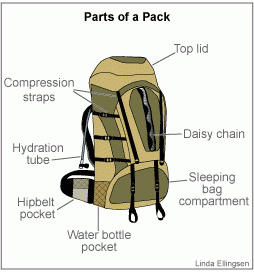Sleeping Bags
Sleeping bags are very important parts of a mountain walker’s equipment. They will be the main source of warmth during the coldest times of day and night. They differ in two main areas, firstly in their shape and secondly in what they are filled with.
Regarding shape they are basically either rectangular or a mummy type shape. The rectangular type has a large area around the leg area making for a more comfortable and looser feel. It is also easier to manufacture and so is cheaper in price. This shape however, also means that there is more area to heat up by the body (colder) and more fabric used which makes it heavier than necessary. Mummy type bags on the other hand are warmer, lighter and are the preferred shape of any properly designed product.
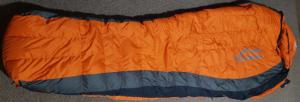
 Mummy shaped sleeping bag with cowl
Mummy shaped sleeping bag with cowl
The filling inside a sleeping bag gives the bag loft, which is the amount of thickness of the layers when un-rolled. This gives a good indication of how much warmth the bag potentially can retain. The filling inside a sleeping bag can be roughly divided into 3 main types: cheap synthetic, hollowfibre and down. Cheap synthetic is exactly what the name implies and should only be considered for casual trips in warm climates. It has little real warmth or lightness, but is cheap. Hollowfibre is a filling made of very fine hollow filaments that trap air inside them and between them. It is a fairly warm filling and retains its warmth when wet. They have a life span of about 10 years if looked after. It has the advantage of being cheaper than down, however, it will not compress as well as down and is also heavier. Down, on the other hand is the first choice for high quality sleeping bags. They are light, have more warmth per weight of filling, compress more easily and last forever if looked after well. The disadvantages are that they lose most of their warmth when wet, are hard to get dry and are far more expensive. The advantages of down far out weigh the disadvantages, making down the preferred choice in most instances.
The internal construction of sleeping bags is very important. In both hollowfibre and down bags there are two major design types. These are sewn-through type construction and a baffle type construction. Both these construction types are to create separate compartments so that the filling does not shift around and remains fairly evenly spread thoughout the bag.
The sewn-though type allows for warmth to escape through the constricted areas where the inner and outer pieces of fabric are brought together. This is a major disadvantage and is not used on well-constructed sleeping bags.
 Sewn through construction. Cheap and light bags.
Sewn through construction. Cheap and light bags.
Baffle type bags have compartments where the two outer layers of fabric are kept apart by a separate inner wall. These compartments have different designs, which could be a zigzag pattern or rectangular shape depending on the manufacture.
 Zigzag baffle type
Zigzag baffle type
 Box wall type
Box wall type
Box wall types are good but not the warmest, they are lighter than V type and costs less.
 Brick wall type
Brick wall type
Brick wall types have good insulation, are heavier and more costly, expedition type bags.
 Trapevoid type
Trapevoid type
Trapevoid types are a combination of box and V types. They are often used in high quality bags.
Most sleeping bags have zips in them to make getting in and out of the bag more comfortable. Zips can vary from a few centimetres in length to a full zip, which runs all the way along one side and across the foot area. Two identical bags of this type can usually be zipped together to form a double sleeping bag.
Hiking Backpacks
Tips for choosing a hiking backpack

Hiking Backpacks
Backpacks need to be made of a water resistant fabric, be very durable, comfortable and the correct size for the number of items to be carried. Making sure that the backpack is comfortable and well adjusted is extremely important as, if this is done badly, the whole expedition can become very un-enjoyable.
Design: There are two major design criteria in Backpacks today. These have to do with how and if they have a frame i.e. external frame, internal frame or no frame. The other consideration is if it is a day bag or an expedition rucksack. Day bags are made for short outings and typically come in sizes up to 35 litres in capacity. They will also usually have no frame at all or may have a soft internal frame. Expedition bags come in sizes from about 40 litres up to 100 litres. They are used for long trips and either have an internal or external frame. Note that these expedition bags are then again divided into two fairly distinctive bag types. The actual bag itself either has lots of internal and external pockets so that items can be accessed easily. This type of design is useful for ordinary mountain walking. On the other hand, some people prefer a design where there is just a single huge compartment. These bags are common with mountaineers and climbers and are often about 50-60 litres in size and have internal frames. Most backpacks today are made of a water resistant material such as Cordura.
Note that this is not waterproof as it does allow for water to escape during dry times and so stops the internal area of the bag becoming mouldy and damp. Backpacks should also have wide, well padded shoulder and hip straps. The shoulder straps (upper point of attachment) must also be able to be moved up and down the back area of the bag. This allows for the bag to be fitted to different sizes of people.
Fitting the Backpack
Most expedition bags available in South Africa today are of an internal frame design and so this section only explains how to adjust a bag for internal frames. Firstly the internal frame needs to be moulded to take the shape of the wearer’s back. Do this by bending the frame while the bag is empty. Make sure that it fills the lower hollow of the back and curves around the shoulders. Then remember that the hip strap should take between about 50% and 70% of the overall weight carried. The upper attachment points of the shoulder straps can usually be adjusted up or down depending on the length of the wearer’s torso. The upper attachment should be at about the shoulder blade height of the wearer. There are straps that join the upper curve of the shoulder straps to the back of the main bag. These need to be fairly tight so as to hold the bag forward against the shoulder.
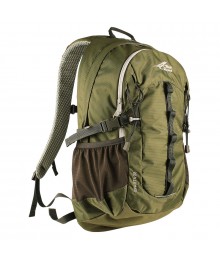
A well designed 20 litre day bag.
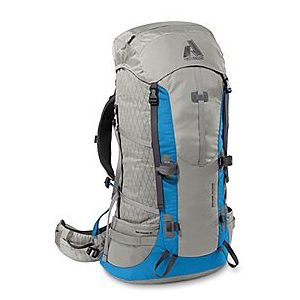
A large 65+ litre expedition bag.
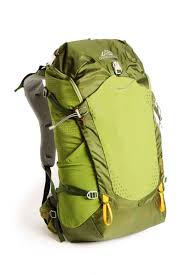
A 35 litre day bag.
Packing a Backpack
The rule here is, “heavy high, light low”. This simple rule just helps to remind you that it is more comfortable to carry heavy items if they are pushing down on the upper shoulders and not hanging below the wearer’s back. Light items such as sleeping bags, spare clothing and a tent flysheet can be carried in the bottom of the bag. Heavy items such as tent poles, stove, fuel and food are carried in the upper area of the bag. There is always a danger of liquid fuels leaking and so these items are best carried in an external pocket within a sealed bag. The same goes for any other liquids that may leak. As backpacks are never fully waterproof it is a good idea to place sleeping bags and clothing in plastic bags or to fit a large garbage packet inside the bag before packing. Try to keep bad weather shell equipment near the top of the bag where they are easily accessible. Tent poles can be placed separately and vertically into the bag as this saves space. Make sure that maps and the compass are easily accessible.
